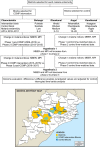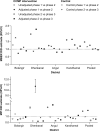Impact of the malaria comprehensive case management programme in Odisha, India
- PMID: 35324920
- PMCID: PMC8947122
- DOI: 10.1371/journal.pone.0265352
Impact of the malaria comprehensive case management programme in Odisha, India
Abstract
Background: The Comprehensive Case Management Project (CCMP), was a collaborative implementation research initiative to strengthen malaria early detection and complete treatment in Odisha State, India.
Methods: A two-arm quasi-experimental design was deployed across four districts in Odisha, representing a range of malaria endemicity: Bolangir (low), Dhenkanal (moderate), Angul (high), and Kandhamal (hyper). In each district, a control block received routine malaria control measures, whereas a CCMP block received a range of interventions to intensify surveillance, diagnosis, and case management. Impact was evaluated by difference-in-difference (DID) analysis and interrupted time-series (ITS) analysis of monthly blood examination rate (MBER) and monthly parasite index (MPI) over three phases: phase 1 pre-CCMP (2009-2012) phase 2 CCMP intervention (2013-2015), and phase 3 post-CCMP (2016-2017).
Results: During CCMP implementation, adjusting for control blocks, DID and ITS analysis indicated a 25% increase in MBER and a 96% increase in MPI, followed by a -47% decline in MPI post-CCMP, though MBER was maintained. Level changes in MPI between phases 1 and 2 were most marked in Dhenkanal and Angul with increases of 976% and 287%, respectively, but declines in Bolangir (-57%) and Kandhamal (-22%). Between phase 2 and phase 3, despite the MBER remaining relatively constant, substantial decreases in MPI were observed in Dhenkanal (-78%), and Angul (-59%), with a more modest decline in Bolangir (-13%), and an increase in Kandhamal (14%).
Conclusions: Overall, CCMP improved malaria early detection and treatment through the enhancement of the existing network of malaria services which positively impacted case incidence in three districts. In Kandhamal, which is hyperendemic, the impact was not evident. However, in Dhenkanal and Angul, areas of moderate-to-high malaria endemicity, CCMP interventions precipitated a dramatic increase in case detection and a subsequent decline in malaria incidence, particularly in previously difficult-to-reach communities.
Conflict of interest statement
The authors have declared that no competing interests exist.
Figures








References
-
- World Health Organization (2021) World malaria report 2021. WHO: Geneva. Available at: https://www.who.int/teams/global-malaria-programme/reports/world-malaria.... Accessed 27 January 2022.
-
- Rae JD, Nosten S, Proux S, Myint Thu A, Cho WC, Paw K, et al.. The role of monitoring and evaluation to ensure functional access to community-based early diagnosis and treatment in a malaria elimination programme in Eastern Myanmar. Malar J. 2019;18:50. doi: 10.1186/s12936-019-2677-2 - DOI - PMC - PubMed
Publication types
MeSH terms
LinkOut - more resources
Full Text Sources
Medical

